
Featured Blog | This community-written post highlights the best of what the game industry has to offer. Read more like it on the Game Developer Blogs.
Navigating the maze using Environmental Narratives
Games use both HUD based tools and environmental narratives for navigation in games. HUDs provide real time information directly to the player but decrease immersion whereas environmental narratives use the environment itself for navigation and increase i

Navigation in games is done by providing important information to the player by either using Heads Up Display, or HUD, based elements like compasses, maps, arrow signs or environmental narratives like landmarks, breadcrumbs and trails. Both of these methods are helpful in games and their use depends on the game’s genre and how the game designers want the player to experience the game.
Let’s start with HUD based navigation first. Greg Wilson in the article Off With Their HUDs described HUD as “A collection of persistent onscreen elements whose purpose is to indicate player status. HUD elements can be used to show, among many other things, how much health the player has, in which direction the player is heading, or where the player ranks in a race.” And also that, “It is accepted shorthand, a direct pipeline from the developer to the end-user” So HUD is useful when the information has to presented directly to the player, which can be beneficial in a lot of situations. But is there something wrong with this medium of information transfer?
Brice Morrison in the book “Game Development Hero” argued that using HUD in games can affect player’s immersion levels. Morrison describes how immersion is achieved in Dead Space and mentions that, “A strong sense of immersion was needed so that the player forgot that they were in a game and instead felt like they were on a derelict spaceship” Describing HUD elements, Morrison stated that, “The result feels outdated and clunky, sometimes filling up the screen and making the players feel like they’re using a word processor instead of entering a virtual world” Greg Wilson mentions the same thing about HUDs, “HUD is not a part of the game world; it is an artificial overlay that is efficient, but often distracts the player from the environment in which he or she is immersed”
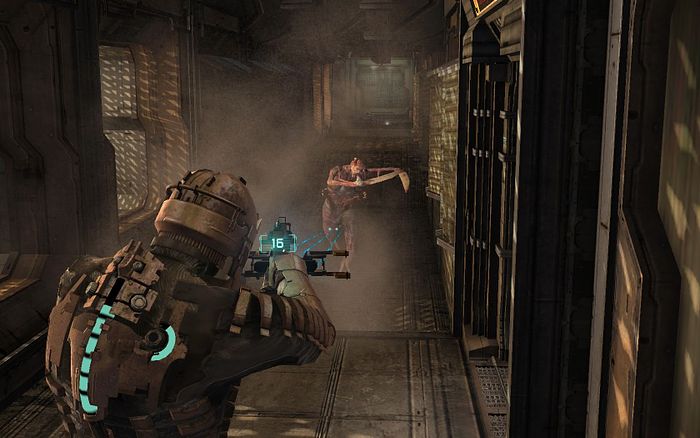
Dead Space. Integrated HUD.
So if HUD affects the player’s immersion levels negatively in the game, can environment and environmental narratives be used instead? But what exactly are environmental narratives? James Swallow, who is a British author and scriptwriter, briefly described environmental narratives on an IGDA writing panel as, “Environmental narrative was about discovery of the story – the players finding it out for themselves – rather than delivery, through dialogue or text” Using environmental narratives in games requires embedding navigational information found on a game’s HUD into the environment which means more work for level designers. Now the question is which navigational method is better? HUD or environmental narratives? Are these methods dependent on certain game genres? Can they be combined together? What are benefits and disadvantages of both? Can one be completely removed from the games in favor of another?
To better answer these questions, let’s delve a little deeper into how HUDs and environmental narratives work and what drawbacks each navigational aid has. I will keep the discussion limited to first person and third person shooters to narrow the focus of this article.

Call of Duty: Modern Warfare 2
So let’s start with HUDs first. For reference, I will take Call of Duty by Activision since the franchise has one of the most played titles and is easily recognized by the players. Call of Duty uses HUD based compass and 2D map to show the objective’s location to the player. Another FPS game Skyrim by Bethesda Softworks uses 3D maps and arrow signs to direct the player to an objective. HUDs in games exist in many different forms which depend on how the HUD is being used in a game. Marcus Andrews in the article Game UI Discoveries: What Players Want, mentions that a HUD is a diegetic if “Interface that is included in the game world -- i.e., it can be seen and heard by the game characters” Holographic HUD used in Dead Space by Electronic Arts is an example of a diegetic HUD. Defining non-diegetic HUD, Andrews stated that “Interface that is rendered outside the game world, only visible and audible to the players in the real world” Compass and 2D maps in Call of Duty series by Activision is an example of such type. The third type is called spatial and Andrews defined this as, “UI elements presented in the game's 3D space with or without being an entity of the actual game world (diegetic or non-diegetic)” The character outlines in Left 4 Dead are an example of non-diegetic spatial HUD. The last one is called Meta and according to Andrews, “Representations can exist in the game world, but aren't necessarily visualized spatially for the player; these are Meta representations. The most apparent example is effects rendered on the screen, such as blood spatter on the camera to indicate damage”

Left for Dead
However, Benjamin Sell wrote an article Heads Up Display: An Investigation Into Video Game HUD’s in which he argued that these types of realism effects do not accurately reflect the character’s status in game and therefore should be reserved for mature audience only. According to Sell (2011), “They are often reserved for video games for a mature audience” Another author, Michael Hartman, in the article Head Up Display: An Investigation Into Characters of Video Game HUD’s discusses how HUDs affect the games negatively, ““Games will placate the user with a neat arrow telling them where to go, as Alan Wake demonstrates, which can be lead to some immersion breaking” and Wilson adds that, “It is not a part of the game world; it is an artificial overlay that is efficient, but often distracts the player from the environment in which he or she is immersed”
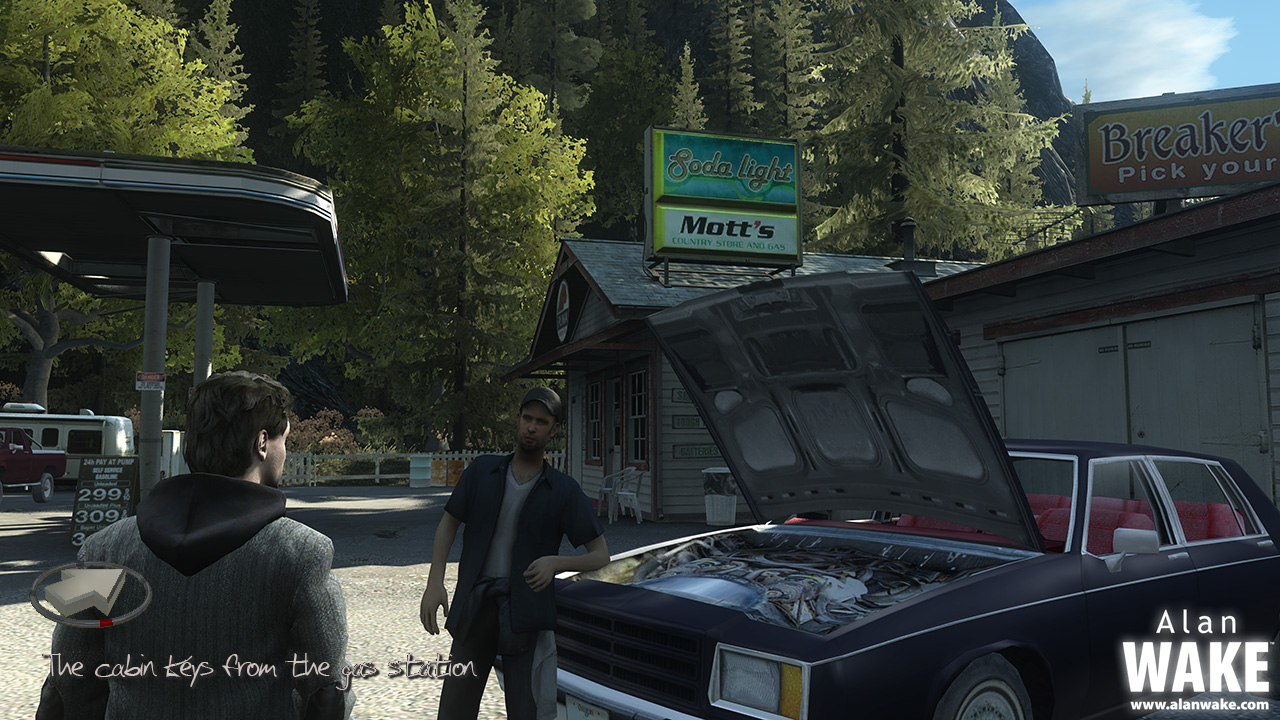
Alan Wake
So from the previous discussion, in order to increase immersion, HUDs have to be minimized or removed from the screen when not in use or removed completely from the game. But if HUDs are removed from the game, then how can the real time navigational information can be relayed to the player? Wilson suggests that, “The most immersive way to present necessary player information is to incorporate it directly into the game environment” Integrating the navigational information in the game’s environment requires the use of environmental narratives like color schemes, landmarks, trails of breadcrumbs or the characters in the game itself. So now is a good time to explore the world of environmental narratives.
To better understand environmental narratives, the words environment and narrative must be analyzed separately. Matt Small, who is the Creative Director of a game development studio called Vector Unit, defined game environments as, “The virtual setting in which the game is played” He explained that an environment is a playable ecosystem that is filled with explorable spaces that the player must navigate, interact with objects, and visit context sensitive locations where events and storytelling take place and the characters and artificial intelligence in game that have personality that lives independent of the player.
So an environment is a space in game where the game’s world, events and characters exist for the player to explore and interact with. One thing that connects these elements with the environment itself is the narrative or the story. Narrative can be defined as, “A story or account of events, experiences, or the like, whether true or fictitious”
Concluding from the previous sections, environmental narratives are various elements in an environment that convey the story of the place. These elements can visually communicate all the happenings that took place in the environment before the player’s arrival without using a long wall of text to explain the situation.
According to James Swallow, “Environmental narrative was about discovery of the story – the players finding it out for themselves – rather than delivery, through dialogue or text” Swallow then used an example from the game Left 4 Dead by Valve. When the player enters a safe room, there is a lot of graffiti on the walls of the room by people who came to this room before the player. Reading the graffiti, the player finds out that some of it narrates the story of the people while some of it warns the player to avoid certain places and some give directions to weapon caches in the level. Using a part of the environment, the designers conveyed a lot of important information to the player.
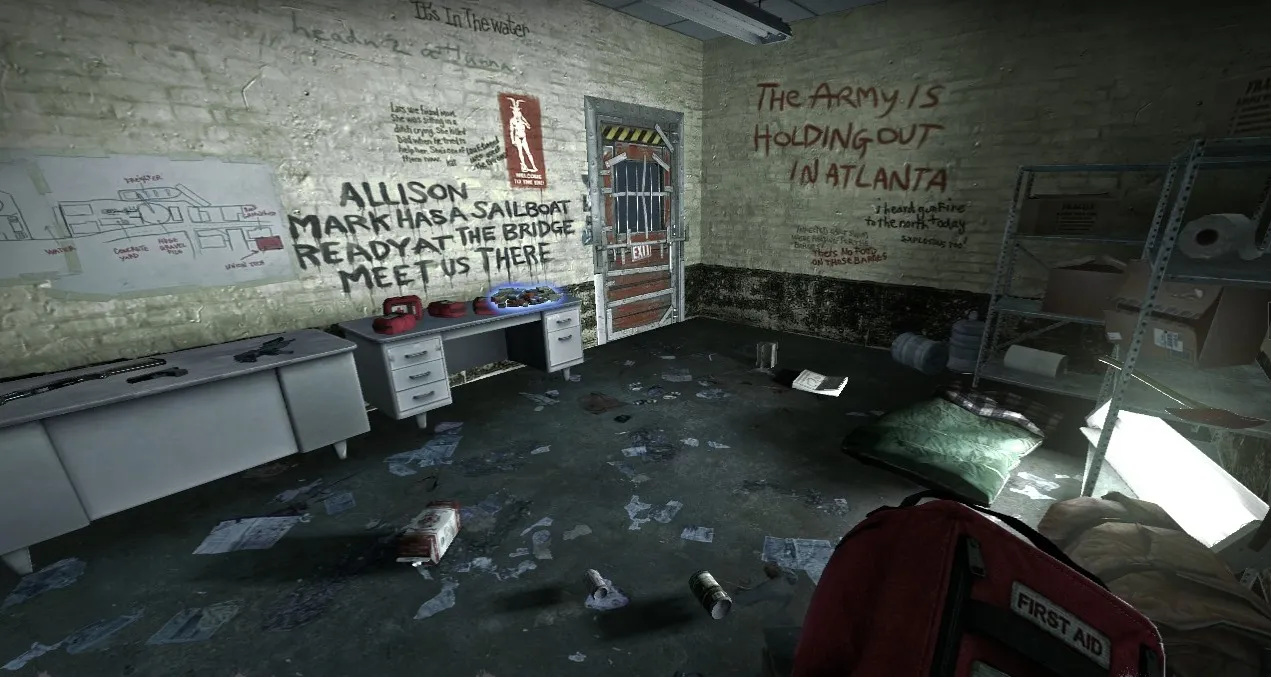
Left for Dead. Clues on the wall.
Author uses another example from the game Half Life by Valve. In this example, important instructions are conveyed to the player using a NPC as an environmental narrative. In certain level in the game, stepping on the sand will get the player killed by a large insect. Swallow explains that there are two ways to warn the player; walls of text explaining the situation or letting the player learn through trial and error. Swallow argued that there is much better alternative to these; using an NPC to show it to the player. This NPC starts running on the sand in front of the player and gets killed; showing the player that walking on the sand is a fatal hazard. I will sum this up with a quote from Wilson “The most immersive way to present necessary player information is to incorporate it directly into the game environment”
There has been a lot of talk of immersion in this article, but what exactly is immersion? Immersion can be defined as, “A state of being deeply engaged or involved”. If a person is really enjoying the experience, it means that the person is totally immersed in the activity and will forget the surrounding world. According to Crawford from the article What is Immersion?, “Immersion is the state where you cease to be aware of your physical self. It is often accompanied by intense focus, distorted sense of time, and effortless action”
Emily Brown in the paper “A Grounded Investigation of Game Immersion” identified three levels of immersions; engagement, engrossment and total immersion. It is necessary to talk very briefly about these levels to understand the concept of immersion on the whole.
According to Brown, “The first stage of immersion is engagement. This is the lowest level of involvement with a game and must occur before any other level” For the player to feel engaged with the game, the three barriers that must be overcome are time, effort and attention before moving to the second stage of immersion. Brown argued that attention is affected by the player’s interest in the game. According to Brown, “If they do not like a certain style of game they will not even try to engage with it”
Moving on to the second level of immersion; Engrossment. This step relies heavily on the game itself and according to Brown, “The barrier to engrossment is game construction. This is when game features combine in such a way that the gamers’ emotions are directly affected by the game” Game construction depends on how much effort and time the game designers have invested in making the game. To make it work, the game features need to be combined in such a way that the player’s emotions are affected by the game only. If the game’s construction is good and flawless, the player will continue playing the game and with time, emotions will be affected by the game even after they have stopped playing the game.
Brown stated that to increase engrossment, “Some gamers purposefully construct a distraction free environment turning out lights and turning up the volume”The use of headphones will cancel any audio distraction from the environment and the only environmental sounds affecting the player’s judgment and mood will be coming from the game itself . If the player is still engaged with the game and is enjoying the storyline and play time, it is likely possible that the player is now engrossed in the game. From here on, achieving total immersion becomes relatively easier and the player starts feeling an emotional attachment with the game’s world and characters.
The last stage of immersion is total immersion. Total immersion is achieved when players are cutoff from reality. Brown described this as, “Being cut off from reality and detachment to such an extent that the game was all that mattered” At this stage, the game is the only thing affecting the player’s thoughts and feelings. Two barriers to total immersion are empathy and atmosphere. According to Brown, “Empathy is the growth of attachment and atmosphere the development of game construction. Empathy is distinct from attachment in that the player feels attached to a main character or team but do not necessarily empathize with their situation”
The three stages of immersion mentioned above discuss about achieving maximum immersion in the game to enjoy the gaming experience to the fullest. Immersion can be affected by artificial elements in the game’s environment that can be part of the HUD as Wilson mentioned, “HUD is not a part of the game world; it is an artificial overlay that is efficient, but often distracts the player from the environment in which he or she is immersed” and if these elements lessen or remove immersion from game, it can give rise to frustration.
So if we are going to prefer environmental narratives over HUD, it is better to understand how navigation is done in real life because HUDs do not exist in real life! We navigate and orient ourselves in real life using number of navigational aids at our disposal like maps, signs, Global Positioning System (GPS) or radars. GPS can be used to find out the exact position of oneself or an objective along with the distance and optimal route to the objective. Another feature that makes GPS an invaluable navigational tools is that it can be used anywhere in the world. Using GPS in real life can be similar to using HUDs in game because it provides direct information to the user. Other methods used for navigation in real life can include analyzing narratives found in the environments. These narratives can include elements like colors schemes, landmarks or a trail of breadcrumbs. These environmental narratives can give clues and help people navigate in real life environments.
Let’s take an example from theme parks, where ‘designers’ make and setup the environment for us, the ‘players’. Both games and theme parks are part of entertainment industry and can have similarities regarding use of navigational strategies. Theme parks make excessive use of environmental signs and narratives for navigation when they draw people to an imagined world and then provide enough entertainment to make them stay there and come again and again. These are the mediums through which designers can narrate stories of the place and environment to the people without using any kind of text or signage and giving them the steering wheel instead of forcing them to follow arrows to their destination. According to Carson, “One of the trade secrets behind the design of entertaining themed environments is that the story element is infused into the physical space a guest walks or rides through. In many respects, it is the physical space that does much of the work of conveying the story the designers are trying to tell. Color, lighting and even the texture of a place can fill an audience with excitement or dread”

Harry Potter billboard at Universal Studios, Orlando. The wand points to the resort.
The author related that when people enter an environment that’s new to them, there are three questions that they ask. Why am I here? What is my relation to this place? How the environment affects me? These questions are similar to what players ask when they start playing a game for the first time. It is the job of the designers to construct the environments in such a way that people find answers to all these questions themselves. According to Carson, “Self discovery can be even more enjoyable than having the story spelled out for you in the opening credits. There are lots of ways designers can place story elements throughout their environments to lead their audience to conclusions designed into the games plot”
We can discuss some environmental narratives that can be used in both a game and real life. These can be in form of colors, lights, textures and props and can be used to draw people’s attention to a point of interest or aid them in navigation. An example can be taken from FPS games like Unreal Tournament 3 by Epic Games that also use color schemes in environments to allow players to quickly orient themselves in complex levels. A level in the game is typically divided into two sides and red and blue color schemes, representing the color of each team, are used to help players differentiate between ally and enemy territories.
Landmarks are another form of environmental narratives that can be used for navigation. Buildings or large props in theme parks provide visual beauty and also serve as point of reference for people. For architecture or building to aid in outdoor navigation, the building must have distinct features that make it standout from the rest of the environment. This will allow the building to be used as landmark for navigation. However, there are problems associated with outdoor navigation. John Muhlhausen wrote an article “Wayfinding Is Not Signage” in which he wrote that, “People who find themselves in unfamiliar environments need to know where they actually are in the complex, the layout of the complex, and the location of their destination in order to formulate their action plans. En route to their chosen destinations, people are helped or hindered prior to their visit, the building's architecture and signage. The physical environment, including positive effect in how users perceive the wayfinding system”
This can also be applied to games as well because players come across the same situation when they start exploring an environment for the first time. Without any kind of navigational aid, the player will have a hard time deciding which path to take and what their destination is. This can be hindrance when achieving total immersion.

Call of Duty: Black Ops. Large excavator in the background can be a landmark
Another way navigation can benefit from props is a trail of breadcrumbs. According to Carson, “Cause and effect is the use of what I call following Saknussemm, derived from the story Journey to the Center of the Earth by Jules Verne. In Verne's story the main characters follow a trail of symbols scratched into subterranean walls by their adventuring predecessor, a sixteenth century Icelandic scientist, Arne Saknussemm. In this way, the game player is pulled through the story by following bread crumbs left behind by a fictitious proceeding game character. Whether you create notes scattered throughout your environments, or have the game player follow the destructive path of some dangerous creature, cause and effect elements will only heighten the drama of the story you are trying to tell”
The author is referencing the story where people traveling to the center of the earth come across writings etched on walls by an Icelandic adventurer that passed through the same passages hundreds of years before them and left a trail of clues and breadcrumbs for them to follow all the way. This not only helps the player in navigation, but also narrates the story of the place and incidents that took place before the player arrived.
For games, an example can be taken from Diablo 2 by Blizzard Entertainment where the player is given a task to hunt down an enemy boss named Duriel in catacombs. The player knows that Duriel is a large insect. In a complex maze of tunnels and corridors, a trail of larvae is seen. Since the player knows that Duriel is also an insect, following the trail leads the player to a chamber where the final battle takes places.
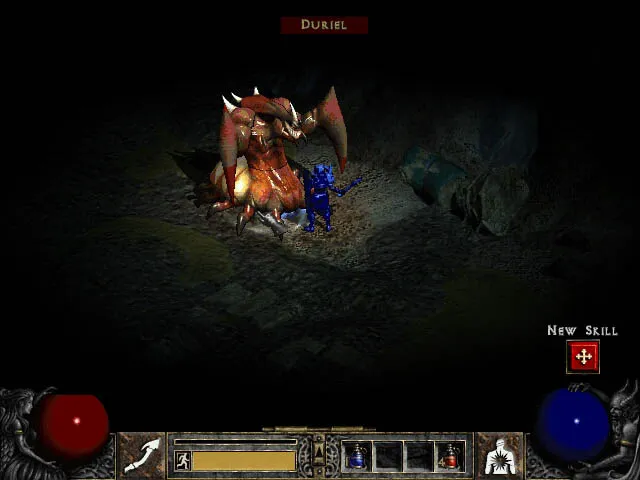
Diablo 2. Fighting Duriel.
This example shows that players pick up trails of breadcrumbs even though no information about the trail was ever given to the players. Here, the third and final stage of immersion i.e. total immersion is achieved because the environment is also navigating the player and no non-environmental aids like arrow signs or compass are telling the player where to go.
Another method of reaching an attraction inside a theme park is just to ask people who have been to that attraction and know the route and can guide or escort others to these locations. This technique is seen in games as well. An example can be taken from Halo 3: ODST by Bungie Games. The game has large environments and this may cause the player to derail from the right path or follow one back to the start. The player can miss important moments and roam around the map aimlessly.
To overcome this problem with navigation, the game uses A.I to help the player. If the player has been roaming around for a long time, the game will spawn few friendly A.I close to the player. The A.I units will converse and inform that the player is lost and should follow them back. Here the player has the choice of following them or going on a different path.
For escorting in games, usually a single A.I unit instructs the player to follow to the objective. In games that use this method, an ally A.I unit will converse with the player to explain why the player has to follow this unit to reach the objective.
An example will be taken from Call of Duty 4: Modern Warfare by Infinity Ward. In a single play level called “All Gilled Up”, the player has to traverse through wastelands of Pripyat in Russia. The player is on a covert mission and the town is filled with enemy units. The player is given an A.I ally which acts as an escort to guide the player through the level, avoid enemy units and work in unison with the player to take down important targets. The A.I informs the player about the choices ahead and the player can make a decision independent of the A.I. Also, the player can abandon A.I and go on a different path. The A.I and game will not force the player to follow the A.I.

Call of Duty 4: Modern Warfare. Following Capt. MacMillan
We have talked about environmental narratives in detail. Are there are limitations or drawbacks to using these for navigation? In some cases, environmental narratives may be absent from the real or a virtual game environment and frustration may arise when the player cannot proceed further in game or virtual environment because of lack of navigational data. An open environment like sea or air does not have any features that the player can relate to. In an article “A Toolset for Navigation in Virtual Environments”, the author, Rudy Darken, mentions that, “A sparse world has large open spaces in which there are few objects or cues to help in navigation. An example of this is a simulation of the surface of the ocean which is populated by only a few objects of interest; ships. Experience has shown that subjects in such a space easily become disoriented” In this situation, a HUD displaying a map or a virtual compass can easily assist the player with navigation. The author also suggested that virtual markers can be placed one after another to form a trail of breadcrumbs for the player to follow. An example can be taken from a FPS game Skyrim by Bethesda Softworks. Skyrim is an open world game and the gigantic game world spans for miles in all directions. Although the environments are rich with visible landmarks, some of the tasks that the player has to finish require travelling to locations that are miles away and beyond visual range. To facilitate the player with navigation, a 2D compass is added to the HUD and a small white arrow is visible all the time on the HUD to show where the objective is. The player can travel in general direction of the white arrow and reach the far away objective.
![]()
Skyrim. Quest markers on the compass.
Environmental narratives have a limitation; they have to be in player’s visual to assist the player with navigation. HUD elements can be combined in situations where environmental narratives may become a problem. If the landmarks are at a great distance and not in player’s visual range, a 2D map can be used to show player the landmark on the map. This will help the player with orientation in the large environment.
Both environmental narratives and HUD based navigational tools can be used in games for navigation. Their use depends on factors like game genre, size and complexity of game environments, and location of the objective. It is important to understand the benefits, limitations and drawbacks of these navigational tools because their use can affect immersion and frustration levels in a game. These tools can be used separately from one another or combined in situations where using one does not fulfill the requirements.
The major benefit of using HUD elements is that they provide information directly to the player, but the drawback of using HUD elements is that they can lower immersion in games. On the other hand, Environmental narratives assist the player with navigation and also narrate the story of the surrounding environment. But this can become a problem with gamers below a certain age level, like 13, who may not be able to differentiate between a texture and a trail of blood. According to Sell, “They are often reserved for video games for a mature audience” This can increase frustration because the player can get lost if the clues are not understood.
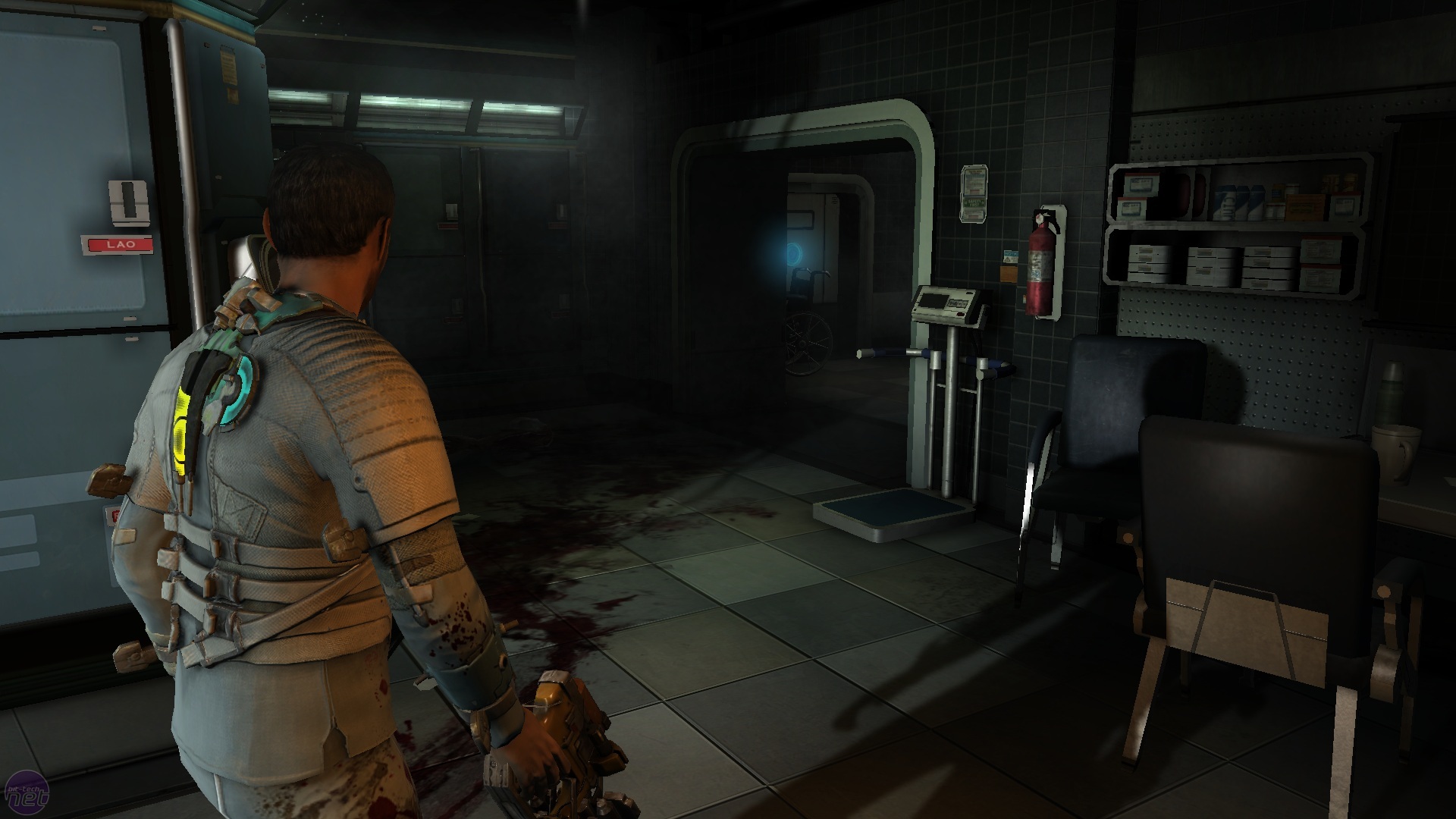
Dead Space 2. A trail of blood.
This discussion shows that neither HUDs nor environmental narratives can be removed entirely from games in favor of another since both have limitations and drawbacks. The viable solution is to combine both. To increase immersion, HUDs can be merged into the game’s environment. Wilson suggested that, “The most immersive way to present necessary player information is to incorporate it directly into the game environment” However, since HUDs affect immersion as well, their usage should be kept to minimum. An example can be taken from FPS game Far Cry 2 by Ubisoft. The game uses diegetic interface by integrating the HUD based navigational elements like 2D compass and maps into gadgets in game. In the game, the time is presented by the wristwatch on character’s wrist, navigation is provided by GPS and a map held in character’s hand.
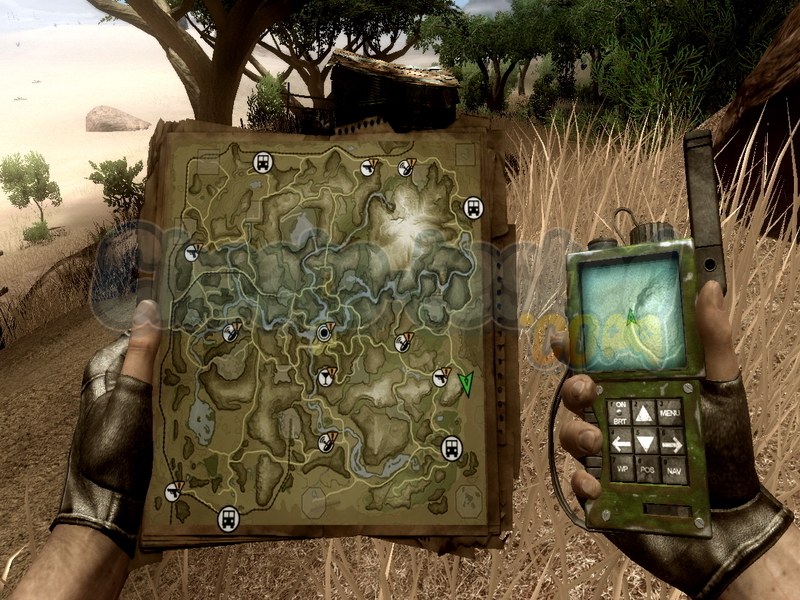
Far Cry 2. Map in hand.
The optimal navigation method is to combine both HUD based elements and environmental narratives in diegetic form where all the navigational elements exist as part of the game’s environment but still display navigational information. This way, a 2D HUD appears as part of the game’s 3D environment and this will not decrease immersion in game.
In this article, I have not used other forms of environmental narratives, like sound and music, can be considered for navigation as well. Furthermore, it has to been seen that if other game genres like racing, simulation and puzzle solving can benefit from environmental navigation as well.
Read more about:
Featured BlogsAbout the Author(s)
You May Also Like









